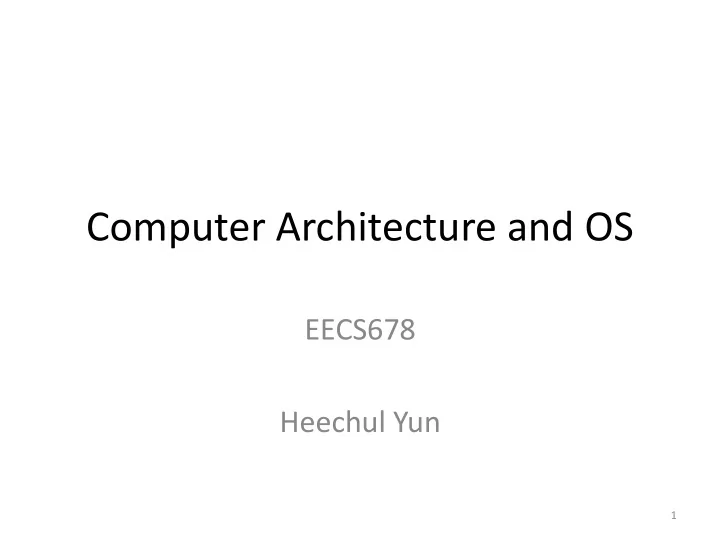

Computer Architecture and OS EECS678 Heechul Yun 1
Administrivia • Labs start this week • Lab homepage – http://people.eecs.ku.edu/~frobinso/ 2
Agenda • Computer architecture and OS – CPU, memory, disk – Architecture trends and their impact to OS – Architectural support for OS 3
Recap • Batch – One at a time. CPU is idle while waiting for I/O – Low throughput • Multiprogramming – If a job needs to way for I/O, switch to a new job – Maximize throughput • Timesharing – Switch to next job after some time – Minimize response time 4
Recap • Essential components of a computer – CPU – Memory – I/O • Memory hierarchy • Caching 5
Recap: Memory Hierarchy Fast, Expensive Slow, Inexpensive 6
Recap: Caching • A very important principle applied in all layers of hardware, OS, and software – Put frequently accessed data in a small amount of faster memory – Fast, most of the time (hit) – Copy from slower memory to the cache (miss) – Low cost, good performance 7
Architectural Support for OS • Interrupts and exceptions • Protected modes (kernel/user modes) • Memory protection and virtual memory • Synchronization instructions 8
Interrupt • What is an interrupt? – A signal to the processor telling “do something now!” • Hardware interrupts – Devices (timer, disk, keyboard, …) to CPU • Software interrupts (exceptions) – Divide by zero, special instructions (e.g., int 0x80) 9
Interrupt Handling save CPU states (registers) execute the associated interrupt service routine (ISR) restore the CPU states return to the interrupted program 10
Timesharing • Multiple tasks share the CPU at the same time – But there is only one CPU (assume single-core) – Want to schedule different task at a regular interval of 10 ms, for example. • Timer and OS scheduler tick – The OS programs a timer to generate an interrupt at every 10 ms. 11
Dual (User/Kernel) Mode • Some operations must be restricted to the OS – accessing registers in the disk controller – updating memory management unit states – … • User/Kernel mode – Hardware support to distinguish app/kernel – Privileged instructions are only for kernel mode – Applications can enter into kernel mode only via pre-defined system calls 12
User/Kernel Mode Transition • System calls – Programs ask OS services (privileged) via system calls – Software interrupt. “ int <num >” in Intel x86 13
Memory Protection • How to protect memory among apps/kernel? – Applications shouldn’t be allowed to access kernel’s memory – An app shouldn’t be able to access another app’s memory 14
Virtual Memory • How to overcome memory space limitation? – Multiple apps must share limited memory space – But they want to use memory as if each has dedicated and big memory space – E.g.,) 1GB physical memory and 10 programs, each of which wants to have a linear 4GB address space 15
Virtual Memory Process A Process C Process B MMU 16 Physical Memory
MMU • Hardware unit that translates virtual address to physical address – Defines the boundaries of kernel/apps – Enable efficient use of physical memory Virtual Physical address address CPU MMU Memory 17
Synchronization • Synchronization problem with threads Deposit(account, amount) { { account->balance += amount; } Thread 1: Deposiit(acc, 10) Thread 2: : Deposiit(acc, 10) LOAD R1, account->balance LOAD R1, account->balance ADD R1, amount STORE R1, account->balance ADD R1, amount STORE R1, account->balance 18
Synchronization Instructions • Hardware support for synchronization – TestAndSet , CompareAndSwap instructions – Atomic load and store – Used to implement lock primitives – New TSX instruction hardware transaction • Another methods to implement locks in single-core systems – Disabling interrupts 19
Summary • OS needs to understand architecture – Hardware (CPU, memory, disk) trends and their implications in OS designs • Architecture needs to support OS – Interrupts and timer – User/kernel mode and privileged instructions – MMU – Synchronization instructions 20
OS Abstractions Reality Abstraction A single computer Multiple computers Limited RAM capacity Infinite capacity Mechanical disk File system Insecure and unreliable Reliable and secure networks 21
Acknowledgements • Some slides are from – Authors of the textbook: Abraham Silberschatz, Greg Gagne, and Peter Baer Galvin – Dr. Prasad Kulkarni 22
Recommend
More recommend